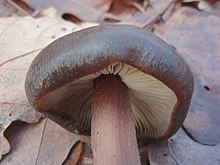Loading AI tools
Genus of fungi From Wikipedia, the free encyclopedia
Rhodocollybia is a genus of Basidiomycete mushroom. Species in this genus, formerly classified as a subgenus in Collybia, have fairly large caps (typically larger than 5 centimetres (2.0 in) broad), and have a pinkish-tinted spore print. Microscopically, they are characterized by having spores and basidia that are dextrinoid—staining deep reddish to reddish-brown with Melzer's reagent when tested for amyloidity. Rhodocollybia species are commonly found in temperate North America and Europe, and infrequently in Central and South America.
| Rhodocollybia | |
|---|---|
 | |
| Rhodocollybia butyracea | |
| Scientific classification | |
| Domain: | Eukaryota |
| Kingdom: | Fungi |
| Division: | Basidiomycota |
| Class: | Agaricomycetes |
| Order: | Agaricales |
| Family: | Omphalotaceae |
| Genus: | Rhodocollybia Singer |
| Type species | |
| Rhodocollybia maculata (Fr.) Singer | |
| Species | |
|
Approx. 30 species – see text. | |
The genus name Rhodocollybia was first used by Rolf Singer in 1939 to describe those species of Collybia with a pink spore deposit;[1] in later works he considered the genera equivalent (synonymous) and called them Collybia.[2][3] In 1997, Antonín and Noordeloos studied various members of Collybia using phylogenetic analysis, and reorganized the genus, dividing species into either Collybia, Gymnopus, or Rhodocollybia.[4]
The caps of species in this genus are relatively large, often more than 5 centimetres (2.0 in) in diameter, convex in shape but in maturity flattening, or often developing a shallow umbo–a mound in the center of the cap. The surface of the cap is often uneven, and slimy or slippery (lubricous) to the touch. The cap color can range from whitish to dark reddish brown. The gills are whitish to pinkish cream in color, and have an adnexed attachment to the stem. The stem is usually long and thick (relative to the cap diameter), often more than 7 centimetres (2.8 in) long and at least 0.5 centimetres (0.2 in) thick; the color usually whitish or the same color as the gills.[5] This type of agaric, collybioid mushroom has pale spore deposits which range from pinkish buff to pinkish cream.[6]
Spores in this species are typically spherical to ellipsoid in shape, and translucent (hyaline). Rhodocollybia is characterized by having an endosporium (inner wall of the spore) that is dextrinoid (staining yellowish or reddish-brown in iodine-containing solutions such as Melzer's reagent), and sometimes cyanophilous.[7][8] The spore wall may be thin to thick (up to 0.5 μm).[5]
Rhodocollybia species are found growing scattered to clustered together on forest duff or on well-rotted wood, in coniferous forests.[5] Species of Rhodocollybia can be found in various parts of the United States, including Maine, Hawaii,[9] and in California in conifer woods on needle duff or on rotting wood.[10] Species in this genus can also be found in such European countries as Poland and the Czech Republic. A 1989 work by mycologist Roy Halling reported three neotropical species: R. turpis from Colombia and Costa Rica, C. popayanica from Colombia, and C. sleumeri from Ecuador.[7]

The following species are recognised in the genus Rhodocollybia:[11]
Seamless Wikipedia browsing. On steroids.
Every time you click a link to Wikipedia, Wiktionary or Wikiquote in your browser's search results, it will show the modern Wikiwand interface.
Wikiwand extension is a five stars, simple, with minimum permission required to keep your browsing private, safe and transparent.